
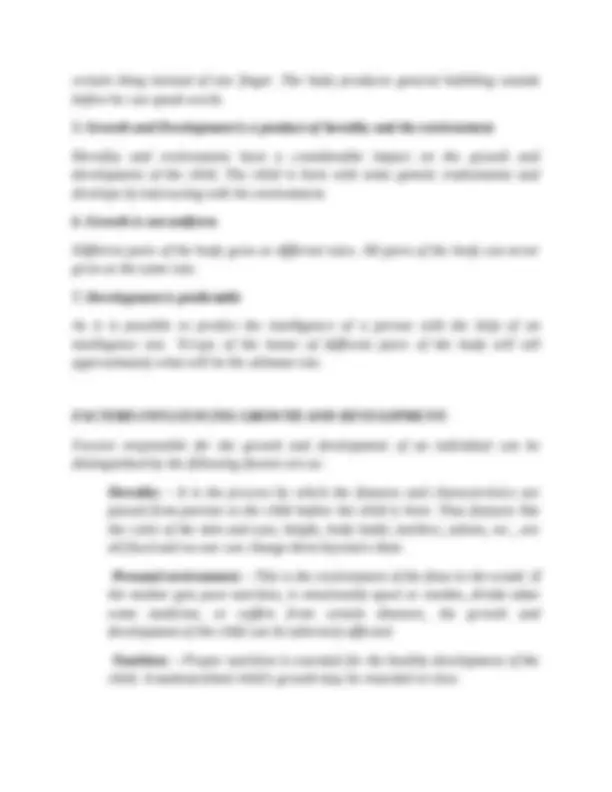
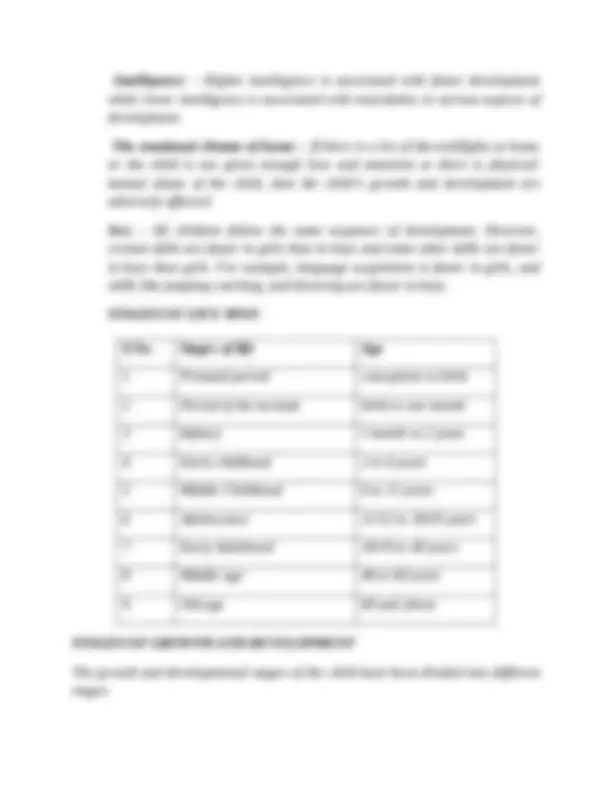
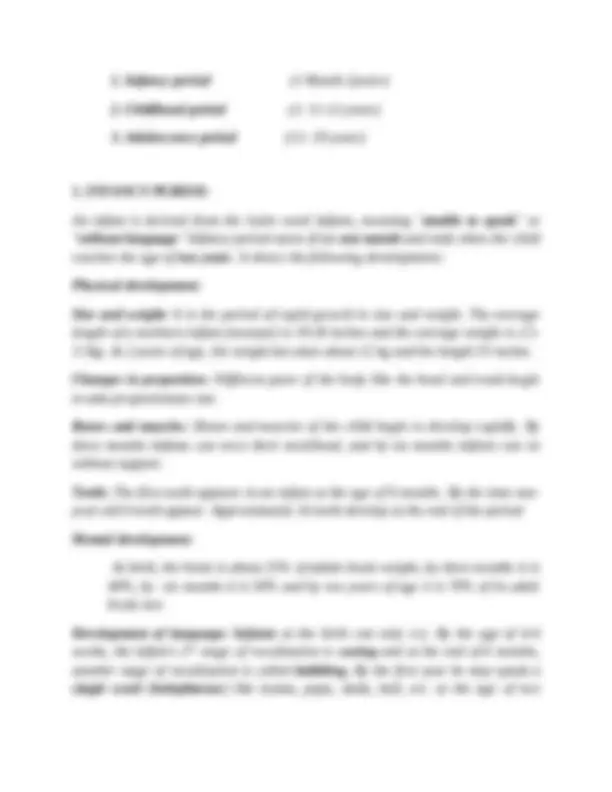
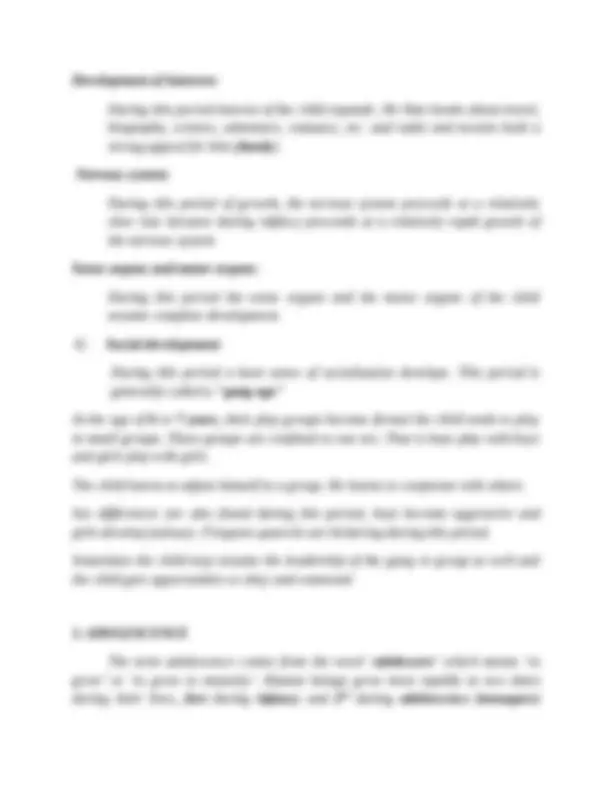
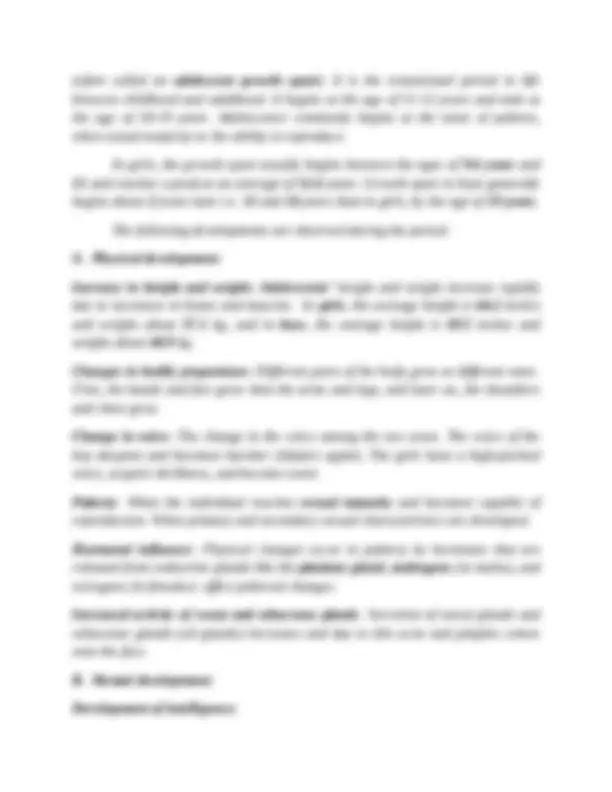
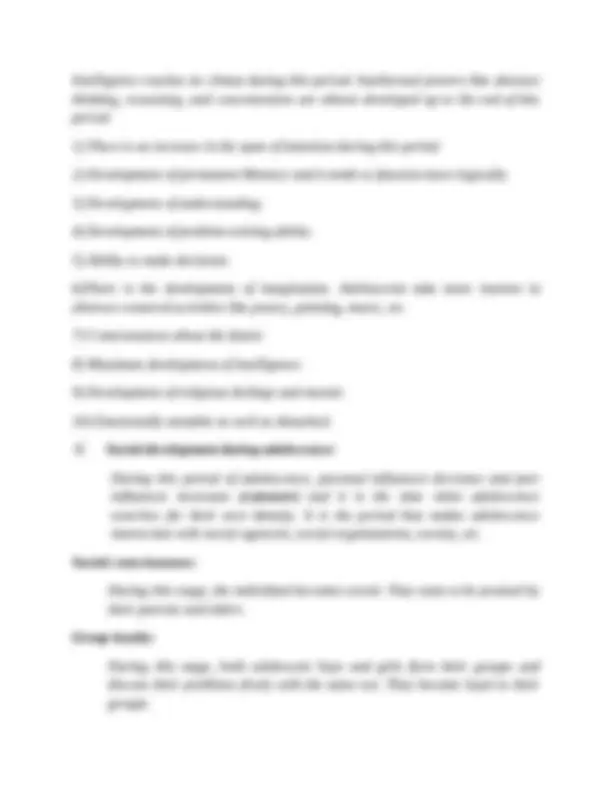
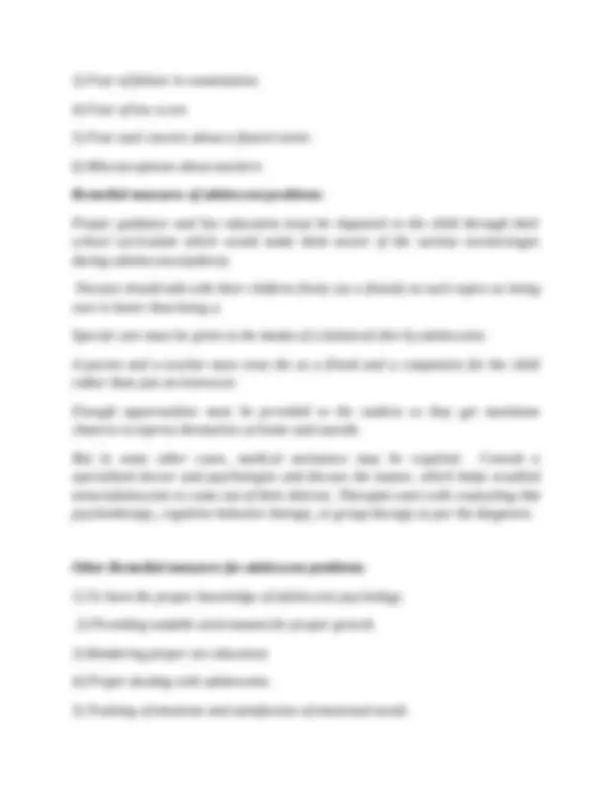



Study with the several resources on Docsity

Earn points by helping other students or get them with a premium plan


Prepare for your exams
Study with the several resources on Docsity

Earn points to download
Earn points by helping other students or get them with a premium plan
Community
Ask the community for help and clear up your study doubts
Discover the best universities in your country according to Docsity users
Free resources
Download our free guides on studying techniques, anxiety management strategies, and thesis advice from Docsity tutors
1.1 Meaning and Principles of Growth and Development 1.2 Stages of Growth and Development (Physical, Mental & Social) with special reference to ** Infancy ** Childhood ** Adolescence 1.3 Needs and Problems of Adolescents with Remedial Measures.
Typology: Study notes
1 / 14

This page cannot be seen from the preview
Don't miss anything!









1.1 Meaning and Principles of Growth and Development 1.2 Stages of Growth and Development (Physical, Mental & Social) with special reference to ** Infancy ** Childhood ** Adolescence 1.3 Needs and Problems of Adolescents with Remedial Measures MEANING OF GROWTH: Growth refers to an increase in the size of body parts or of the organism as a whole. It can be measured or quantified. E.g. growth in height , weight, size, etc. In other words, growth refers to cell multiplication or quantitative changes in size, weight , and number or growth of the heart , brain , muscles, and body in general. MEANING OF DEVELOPMENT: Development is a broader term than growth. Development may be defined as a progressive series of orderly, coherent changes. The various developments that take place during the lifetime of an individual are physical , motor, social, emotional, intellectual, aesthetic, and moral. Developmental Psychology is the branch of psychology that studies intra- individual and inter-individual changes. Development is a process by which an individual grows and changes throughout the life cycle. Or it refers to qualitative and quantitative changes that begin at conception and continue through the life span. It includes both the gains and losses throughout the life span e.g. ability to sit, stand, walk , learn to talk, etc or refers to changes in structure, form, or shape as well as improvement in functioning both implies qualitative and quantitative changes. DIFFERENCE BETWEEN GROWTH AND DEVELOPMENT:
Growth Development
Intelligence: - Higher intelligence is associated with faster development while lower intelligence is associated with retardation in various aspects of development. The emotional climate of home: - If there is a lot of discord/fights at home or the child is not given enough love and attention or there is physical/ mental abuse of the child, then the child’s growth and development are adversely affected. Sex: - All children follow the same sequence of development. However, certain skills are faster in girls than in boys and some other skills are faster in boys than girls. For example, language acquisition is faster in girls, and skills like jumping catching, and throwing are faster in boys. STAGES OF LIFE SPAN STAGES OF GROWTH AND DEVELOPMENT The growth and developmental stages of the child have been divided into different stages: S.No. Stages of life Age
1. Infancy period (1 Month-2years) 2. Childhood period (2- 11-12 years) 3. Adolescence period (12- 19 years) 1. INFANCY PERIOD: An infant is derived from the Latin word infants, meaning " unable to speak " or " without language " Infancy period starts from one month and ends when the child reaches the age of two years. It shows the following developments: Physical development: Size and weight: It is the period of rapid growth in size and weight. The average length of a newborn infant (neonate) is 19-20 inches and the average weight is 2.5- 3.5kg. At 2 years of age, his weight becomes about 12 kg and his length 33 inches. Changes in proportion: Different parts of the body like the head and trunk begin to take proportionate size. Bones and muscles: Bones and muscles of the child begin to develop rapidly. By three months Infants can erect their neck/head, and by six months infants can sit without support. Teeth: The first tooth appears in an infant at the age of 6 months. By the time one- year-old 4 teeth appear. Approximately 16 teeth develop at the end of the period. Mental development: At birth, the brain is about 25% of adults brain weight, by three months it is 40%, by six months it is 50% and by two years of age it is 70% of its adult brain size Development of language: Infants at the birth can only cry. By the age of 4- weeks, the infant's 2 nd stage of vocalization is cooing and at the end of 6 months, another stage of vocalization is called babbling. By the first year he may speak a single word ( holopharase ) like mama, papa, dada, ball, etc. at the age of two
It is a period of slow, steady, and uniform growth. The child’s height at the age of 6 years is about 45.5 inches and 19-20 kg in weight and by 12 years is about 59 inches in height and 41.5 kg in weight. Bodily proportions: Bodily proportions change considerably and alter the overall appearance of the child. Arms, legs, and trunk increase in length, and the period of thinness begins. Growth and coordination of muscles: There is rapid and greater muscular growth during the period. Teeth: Most children have a full set of 20 milk teeth by 3 years old. When they reach 5-6 years, the teeth of infancy start falling and the permanent teeth start growing from 12 years. Sex difference: During this period sex differences influence physical growth. A girl is taller on average by half an inch and weighs more on average by 3 pounds than a boy. B. Mental development: Language development: The vocabulary of the child at the age of 12 is sufficiently rich. He can speak sentences fully and well. Curious questions: The question put by the child in this period is more definite than he used to put during his infancy. Development of power of thinking: During this period of development the power of observation, thinking, reasoning, remembering, recalling, attention, etc.
Development of interests: During this period interest of the child expands. He likes books about travel, biography, science, adventure, romance, etc. and radio and movies hold a strong appeal for him ( dandy ). Nervous system: During this period of growth, the nervous system proceeds at a relatively slow rate because during infancy proceeds at a relatively rapid growth of the nervous system. Sense organs and motor organs: During this period the sense organs and the motor organs of the child assume complete development. C. Social development: During this period a keen sense of socialization develops. This period is generally called a “ gang age ” At the age of 6 or 7 years, their play groups become formal the child tends to play in small groups. These groups are confined to one sex. That is boys play with boys and girls play with girls. The child learns to adjust himself to a group. He learns to cooperate with others. Sex differences are also found during this period, boys become aggressive and girls develop jealousy. Frequent quarrels are bickering during this period. Sometimes the child may assume the leadership of the gang or group as well and the child gets opportunities to obey and command
3. ADOLESCENCE The term adolescence comes from the word ‘ adolescere ’ which means ‘to grow’ or ‘to grow to maturity’. Human beings grow most rapidly at two times during their lives, f irst during infancy and 2 nd during adolescence (teenagers)
Intelligence reaches its climax during this period. Intellectual powers like abstract thinking, reasoning, and concentration are almost developed up to the end of this period.
Social service: During this stage, ideas of social service are formed. Social service in public gatherings, fairs, and festivals become a passion for adolescents. Peer group influence : Adolescents spend most of their time outside the home with members of the peer group. Need of Adolescence: Primary or physiological needs: These are termed as basic needs of an individual such as air, water, food, safety needs, and belongingness needs. Need for security: The adolescent needs emotional, social, and economic security in addition to physical security. Need for love: Adolescents have a strong desire to love and to be loved. Need for freedom: Adolescent wants freedom so that they can express their feelings, emotions, and ideas. Problems of Adolescence: Adolescence is the most crucial period of human development. In this stage, when children become sexually mature and reach the age of legal maturity. It is the period of rapid changes in the individual’s physical, mental, moral, emotional, spiritual, sexual, and social outlook. The most important fact about adolescence is that it is a period of transition from childhood to adulthood that is always associated with some problems. Most problems of adolescence are classified as: a) Physical Problems b) Psychological Problems c) Social Problems d) Educational Problems Physical Problems